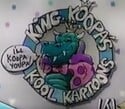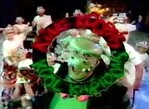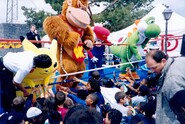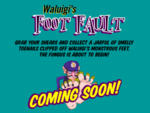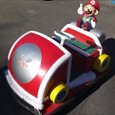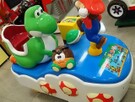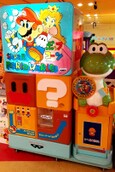User:Yossy/Sandbox
Lost media is a term used to describe content (such as videos, audio recordings, photos, and literature) that is not available to the general public and may be unaccounted for. Due to a lack of interest in archiving everything from the Mario franchise, several pieces of officially licensed Mario related media have been lost.
To see unreleased or cancelled video games that may qualify as lost media, see List of unreleased media.
Currently lost media
Club Mario
- Main article: Club Mario
Club Mario was a series that briefly replaced the live-action segments in the The Super Mario Bros. Super Show! It centered around two Mario-obsessed teenagers named Tommy Treehugger and Co-MC, who were respectively played by Chris Coombs and Michael Rawlins. The series began on July 23, 1990[1] and presumably ended later that year.
27 of the 65 Club Mario segments are completely lost. This includes the ones from Butch Mario & The Luigi Kid, Love 'Em and Leave 'Em, The White Knight, Toad Warriors, Two Plumbers and a Baby, Koopenstein, On Her Majesty's Sewer Service, Mario and Joliet, Too Hot to Handle, Hooded Robin and His Mario Men, Mighty McMario and the Pot of Gold, Mario Meets Koop-zilla, Doppelganger, Bad Rap, Underworld Connections, The Mark of Zero, The Great Gold Coin Rush, Elvin Lives, Plummers Academy, Karate Koopa, Mario of the Apes, Princess; I Shrunk the Mario Brothers, Little Red Riding Princess, Fairies in the Spring, Raiders of the Lost Mushroom, Crocodile Mario, and Star Koopa. The segment from The Adventures of Sherlock Mario is partially lost.[2]
King Koopa's Kool Kartoons
- Main article: King Koopa's Kool Kartoons
King Koopa's Kool Kartoons was a live-action television show created by DIC Entertainment. It centered around King Koopa (played by Christopher Collins and eventually Patrick Pinney), whose personality and appearance was based on his character in the The Super Mario Bros. Super Show! He would host quizzes that viewers could answer through sending mail, respond to viewer-submitted questions, and play cartoons from the public domain that had nothing to do with the Mario franchise.[3]
The show ran from September 11, 1989 to November 20, 1989 and aired 65 episodes before its cancellation. It aired in Southern California;[4] Tucson, Arizona;[5] and El Paso, Texas.[6] Due to the show's poor reception, short lifespan, and limited availability, only a few clips of King Koopa's Kool Kartoons are available.[7]
Maestro Mario
Maestro Mario was a browser game featured on the official Mario Party website in 1999. It used Adobe Shockwave and information about the game is scarce.[8]
Nintendo Arcade
- Main article: Nintendo Arcade
The Nintendo Arcade was a page on Nintendo's official website that hosted browser games to promote recent and upcoming game releases. It ran from 2006 to late 2007 before it was taken down. Fourteen of its 38 games are currently lost. This includes 1-Up Hunt!, Super Paper Mario Memory Match, Wario: Master of Disguise Trivia, and Yoshi's Egg Toss.[9]
Saturday Supercade
- Main article: Saturday Supercade
Saturday Supercade was an animated television show that ran for two seasons from September 17, 1983 to December 1, 1984. Each episode was around an hour long and split into four different segments featuring characters from popular arcade games, including Donkey Kong and Donkey Kong Jr. Officially licensed home media for Saturday Supercade is extremely limited (likely due to licensing issues) and reruns of the show were rare, causing several segments to become lost.
Little Orphan Apey, Apey and the Snowbeast, Private Donkey Kong, Sir Donkey Kong, and The Pale Whale are missing Donkey Kong segments. The Jungle Boy Ploy is a completely missing Donkey Kong Jr. segment, while The Ventriloquist Caper and The Great Seal Steal are partially lost.[10]
Slamfest '99
- SmashWiki article: Super Smash Bros. Slamfest '99
Slamfest '99 was an event hosted on April 24, 1999 to promote the release of Super Smash Bros.[11] It took place at the MGM Grand Adventures Theme Park in Las Vegas and lasted from 11:00 A.M. to 1:00 P.M.[12] Due to the Columbine High School Massacre happening four days prior to the event, Slamfest '99 was mostly advertised in video game-centric internet communities, rather than mainstream media. Audience members mainly consisted of children from the Andre Agassi Foundation[13] and several video game magazine reporters. Demo booths were set up for attendees to play Super Smash Bros. before and after the wrestling match.[11]
The main event was a seventeen minute[14] wrestling match between four Cirque du Soleil members (who also choregraphed the performance)[13] wearing costumes of Donkey Kong (whose nickname for Slamfest '99 is unknown due to his profile not being archived), Mario (nicknamed The Italian Stallion),[15] Pikachu (nicknamed The Beast from the Far East),[16] and Yoshi (nicknamed The Dinosaur of Disaster).[17] At some point, the referee became involved in the fight and bit Pikachu's ear, claiming it tasted like chicken.[18] It ended with all four wrestlers crashing into each other and knocking themselves out, leading to the referee announcing everybody as the winner.[19]
Slamfest '99 was broadcasted online by Media On Demand (now Onstream Media)[20] and could be re-watched with RealPlayer G2.[21] A link to the broadcast contained a .ram (Real Audio Metadata) file, which contained the URL to a server that played the video.[20] The event's webpage was removed before August 2000 and archives from the Wayback Machine do not display any files.[21] As of May 2023, the broadcast has never been found.
A search for video footage of Slamfest '99 has been ongoing since 2020.[11] According to a former Media On Demand employee, it would've been up to Nintendo to decide if they wanted to keep an archive of the broadcast.[20] Ed Espinoza, a former Nintendo employee who produced and scripted Slamfest '99, believes a public relations firm might have an archive or an idea on where one may be.[13]
The most recent update in the search for Slamfest '99 was on February 13, 2023, when previously unseen photos of the event were uploaded to Imgur.[22]
Gallery
Waluigi's Foot Fault
- Main article: Waluigi's Foot Fault
Waluigi's Foot Fault (also known as Waluigi's Toenail Clipping Party) was a browser game released sometime in mid-to-late 2000. According to issue 136 of Nintendo Power, the player would clip Waluigi's toenails and catch them with a jar.[23]
Several files could be found on the official Mario Tennis website and would automatically download to the user's computer. A file titled toenails_coming.swf contains an advertisement for the game,[24] but a file titled toenails.swf (which is presumably the game's file) was not archived and cannot be viewed.[25] A playable version of Waluigi's Foot Fault has not been found.[26]
Additionally, two more unarchived files titled paint_the_lines.swf[27] and deface_painting.swf[28] were recovered from the Mario Tennis website in May 2022.[29] It is unknown if these were browser games as well and what their gameplay consisted of.
Formerly lost media
Mario Net Quest
- Main article: Mario Net Quest
Mario Net Quest is a browser game that was developed by C3 Incorporated[30] and released on March 14, 1997 by IBM.[31] It was created to promote the IBM AS/400 series, which was advertised as "[helping] Nintendo with one of the most successful launches in video game history."[32] IBM also hosted a giveaway that consisted of hats, Nintendo 64 consoles, and games.[30]
Gameplay consists of the player controlling Mario with a computer mouse for sixty seconds (unless they click on Bowser, which will instantly end the game). The player would receive points by clicking on coins, red coins, and power stars. Points would be deducted if the player clicked on Bullies, Goombahs[sic], and Boos. The game could be played on the IBM AS/400 series official website,[33] but was removed by December 1997.[34]
In April 2023, Mario Net Quest resurfaced when its Adobe Shockwave file was found on a "secret page" from a Mario fansite.[35]
References
- ^ Elizabeth Jensen (July 20, 1990). Dot's All... New York Daily News. Retrieved on May 11, 2023.
- ^ Club Mario on the Lost Media Wiki. Retrieved on May 12, 2023.
- ^ King Koopa's Kool Kartoons. IMDb. Retrieved on April 25, 2023.
- ^ MlacanoSP (December 8, 2005). King Koopa's Kool Kartoons. Retro Junk. Retrieved on April 25, 2023.
- ^ TV channel guide from the Tucson Citizen (November 6, 1989). Retrieved on April 25, 2023.
- ^ TV channel guide from the El Paso Herald-Post (October 21, 1989). Retrieved on April 25, 2023.
- ^ King Koopa's Kool Kartoons on the Lost Media Wiki. Retrieved on April 25, 2023.
- ^ Mario Party's official website. Archived on the Wayback Machine on october 13, 1999. Retrieved on July 15, 2023.
- ^ Nintendo Arcade on the Lost Media Wiki. Retrieved on April 28, 2023.
- ^ Saturday Supercade on the Lost Media Wiki. Retrieved on May 5, 2023.
- ^ a b c Slamfest '99 on the Lost Media Wiki. Retrieved on April 24, 2023.
- ^ Nintendo Stages Smashing Fight (April 21, 1999). IGN. Retrieved April 24, 2023.
- ^ a b c GameXplain (November 9, 2021). Searching for Nintendo's Lost Smash Bros. 64 Event: Slamfest '99 - We Talk to One of the Creators! YouTube. Retrieved April 24, 2023.
- ^ Berghammer, Billy (April 26, 1999). This beats Monday Night RAW! Nintendo World Report. Retreived on April 24, 2023.
- ^ Mario's profile for Slamfest '99. Archived on the Wayback Machine on October 9, 1999. Retrieved on April 24, 2023.
- ^ Pikachu's profile for Slamfest '99. Archived on the Wayback Machine on November 3, 1999. Retrieved on April 24, 2023.
- ^ Yoshi's profile for Slamfest '99. Archived on the Wayback Machine on October 9, 1999. Retrieved on April 24, 2023.
- ^ Slamfest: Bizarre live Smash Bros rumble (June 1999). N64 magazine. Retrieved on April 25, 2023.
- ^ Super Smash Bros. Slamfest '99 (April 24, 1999). Zelda 64 Planet. Retrieved on April 24, 1999.
- ^ a b c LSuperSonicQ (November 22, 2021). The Lost Nintendo Event that Might Be Gone Forever - SLAMFEST '99 (Update #2). YouTube. Retrieved on April 25, 2023.
- ^ a b The melee of the millennium! Archived on the Wayback Machine on September 8, 1999. Retrieved on April 24, 2023.
- ^ Slamfest '99 - New Photos from Ed Espinoza (February 13, 2023). Imgur. Retrieved on April 25, 2023.
- ^ Mamma Mia! It's Waluigi! (September 2000) Issue 136 of Nintendo Power. Retrieved on April 27, 2023.
- ^ toenails_coming.swf. Mariotennis.com. Archived on the Wayback Machine on October 17, 2000. Retrieved April 27, 2023.
- ^ toenails.swf. Mariotennis.com. Archived on the Wayback Machine on September 10, 2011. Retrieved on April 27, 2023.
- ^ Waluigi's Toenail Clipping Party on the Lost Media Wiki. Retrieved on May 5, 2023.
- ^ paint_the_lines.swf. Mariotennis.com. Archived on the Wayback Machine on September 10, 2011. Retrieved on April 27, 2023.
- ^ deface_painting.swf. Mariotennis.com. Archived on the Wayback Machine on December 30, 2011. Retrieved on April 27, 2023.
- ^ MediaMonster (May 6, 2022). The Waluigi Toenail Clipping Flash Game is REAL. Forums - The Lost Media Wiki. Retrieved on April 27, 2023.
- ^ a b Pedersen, B. Martin (1999). InteractiveDesign1: The International Collection of New Media Design (Page 167). Graphis Inc. ISBN 9781888001631. Retrieved on May 26, 2023.
- ^ Mario Net Quest. The Mushroom Kingdom. Retrieved on May 26, 2023.
- ^ Advertisement from The Independent (May 13, 1997). Retrieved on May 26, 2023.
- ^ Homepage for the IBM AS/400 series website. Archived on the Wayback Machine on May 7, 1997. Retrieved on May 26, 1997.
- ^ Homepage for the IBM AS/400 series website. Archived on the Wayback Machine on December 11, 1997. Retrieved on May 26, 2023.
- ^ WaifuGroove (April 14, 2023). (Found) (1997) Mario Net Quest -- The first official Mario browser game, published by IBM. Reddit. Retrieved on May 26, 2023.
Go Go Yoshi
Go Go Yoshi (いけいけヨッシー, Ike Ike Yosshī) was a coin-operated children's ride shown at Japan's annual Amusement Machine Show in 1993.[1]
Super Mario Drive
Super Mario Drive (スーペーマリオドライプ, Sūpā Mario Doraibu) consisted of two coin-operated two bumper karts, one featuring Mario and another featuring Yoshi. They were shown at Japan's annual Amusement Machine Show in 1993.[1] While driving, both karts would play an off-pitch version of Super Mario World's title screen music.[2][3] The Yoshi car measured 98 centimetres tall, 90 centimetres wide, and 130 centimetres long.[4]
Super Mario Seesaw
Super Mario Seesaw (スーペーマリオシーソー, Sūpā Mario Shīsō) was a coin-operated children's ride shown at Japan's annual Amusement Machine Show in 1993.[1]
Super Mario World Popcorn
Super Mario World Popcorn (スーパーマリオワールドポップコーン, Sūpā Mario Wārudo Poppukōn) was a popcorn vending machine shown at Japan's annual Amusement Machine Show in 1993[5] and distributed in 1994. It measured 180 centimetres tall, 134 centimetres wide, 73 centimetres narrow, and initially costed ¥1,350,000.[6] The popcorn came in three diifferent flavours and the machine would give users free rameune candy if they won a built-in roulette game.[7]
Tobetobe Mario
Tobetobe Mario (とべとべマリオ, Tobetobe Mario) was a coin-operated children's ride shown at Japan's annual Amusement Machine Show in 1991.[8]
- ^ a b c Amusement Press, Inc (October 15, 1993). Game Machine Magazine no. 459 (Page 20). Retrieved on July 16, 2023.
- ^ ケータママ&バイキンマンフミちゃん&アンパンマン (November 30, 2021). BANPRESTO スーパーマリオドライブ. YouTube. Retrieved on July 16, 2023.
- ^ ケータママ&バイキンマンフミちゃん&アンパンマン (January 10, 2018). BANPRESTO スーパーマリオドライブ・ヨッシー . YouTube. Retrieved on July 16, 2023.
- ^ ヨッシー(バッテリーカー) (March 31, 2015). All Rental. Retrieved on July 16, 2023.
- ^ Amusement Press, Inc (October 15, 1993). Game Machine Magazine no. 459 (Page 23). Retrieved on July 16, 2023.
- ^ Amusement Press, Inc (September 15, 1994). Game Machine Magazine no. 480 (Page 19). Retrieved on July 15, 2023.
- ^ Amusement Press, Inc (December 15, 1994). Game Machine Magazine no. 486 (Page 11). Retrieved on June 28, 2023.
- ^ Amusement Press, Inc (November 15, 1991). Game Machine Magazine no. 415 (Page 10). Retrieved on July 16, 2023.

